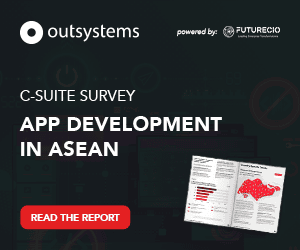"Sustainable development is the development that meets the needs of the present without compromising the ability of future generations to meet their own needs," shared Norwegian politician and chair of the World Commission on Environment and Development, Gro Harlem Brundtland.
With climate change and rising emissions, sustainability is not just a trend but a need for organisations.

Information technology (IT) consultancy Crayon's chief sales officer, Gudmundur Adalsteinsson, shared their best practices and how CIOs and tech leaders across APAC can scale their sustainable IT initiatives.
Reducing carbon footprint
Adalsteinsson highlighted implementing several sustainable IT initiatives to reduce carbon emissions, such as running data centres entirely on renewable energy sources and not utilising water for cooling.
"In transitioning to outsourced cloud hosting, we rely on our contracted service providers to proactively minimise their carbon footprint," he noted.
Beyond data centres, sustainability commitment also applies to device lifecycle management, which adopts a holistic approach to procuring and disposing of internal IT equipment and hardware.
"Other sustainability criteria such as repairability and recyclability are also taken into account to promote circular economy principles," he added.
Adalsteinsson also emphasised customer-facing initiatives, including software optimisation. He highlighted how the initiative encourages customers to deploy software that monitors their energy consumption and overall carbon footprint. This will help facilitate the data collection needed to make meaningful changes aligned with their long-term environmental goals.
According to Adalstennsson, encouraging customers to consider the energy-efficient data centres of hyperscalers also contributes to sustainability objectives.
Overcoming challenges
Initiating sustainable practices in IT enhances competitive edge and reputation, but it comes with challenges. Adalsteinsson said that one of the most significant challenges is balancing the need for high-performance infrastructure with sustainability goals.
"Technologies such as AI and machine learning, which drive business innovation, require high computational power and thus significant energy consumption," he explained.
Recognising the shared responsibility in the tech industry, Adalsteinsson highlighted the need to collaborate with cloud and infrastructure providers with the same focus on sustainability and actively track international climate policy discussions to ensure participation in a global movement towards sustainability.
"Another challenge is ensuring internal and external stakeholders understand the value of adopting sustainable IT solutions without compromising efficiency. We raise awareness of our FinOps-enabled platforms, which can provide real-time visibility into both financial and carbon performance across hybrid cloud environments," Adalsteinsson added.
Operational costs implications
Adalsteinsson said that adopting sustainable IT practices has led to "a mix of outcomes in terms of costs."
He pointed out that the shift to cloud-based operations and virtualisation has delivered significant long-term savings by reducing energy usage and minimising maintenance expenses. It also improved efficiency, leading to measurable cost reductions.
Innovation and sustainability
Operational cost is just one aspect to consider. Another important consideration is how technologies like AI align with sustainability goals.
"We believe sustainability and AI interests can complement each other rather than compete. AI technologies, when deployed with a focus on efficiency, can significantly enhance resource optimisation and reduce waste across IT operations," Adalsteinsson said.
He shared that AI-driven cloud systems can dynamically manage workloads and reduce energy consumption during periods of lower demand.
Adalsteinsson recognised that the current focus on AI innovation might temporarily overshadow sustainability efforts as companies prioritise computing power and speed.
He encourages customers to use energy-efficient AI frameworks like small language models (SLMs), which IBM defines as AI models that can process, understand, and generate natural language content with a smaller scale and scope than large language models (LLMs).
Adalsteinsson said they consume less computational power than larger models, offering a sustainable alternative without compromising results.
"This allows organisations to achieve both innovation and sustainability goals," Adalsteinsson added.
Creating a company's ESG strategy
Aligning technology and sustainability highlights the need for comprehensive ESG strategies. However, lasting impact requires leaders to play a critical role in embedding sustainability into business operations.
Tech leaders and CIOs are essential contributors in formulating and implementing a company's ESG strategy.
"Tech leaders and CIOs are essential contributors in formulating and implementing a company's ESG strategy, collaborating with ESG subject matter experts and other internal stakeholders," said Adalsteinsson.
He encourages them to integrate sustainability into their core IT operations and decisions.
"In the APAC context, this can mean adopting energy-efficient cloud solutions and ensuring that procurement practices align with vendors committed to sustainable operations, he added.
Adalsteinsson urges organisations to adopt a lifecycle approach to hardware, from acquisition to responsible disposal, embracing the principles of the circular economy to minimise waste.
He remarked that leaders will benefit from leveraging data analytics to track ESG progress: "Integrating this data into decision-making processes will help leaders stay accountable and continuously improve."
Aside from that, he also underscored the importance of stakeholder engagement.
Engaging employees across departments fosters a shared commitment to sustainability.
"Engaging employees across departments fosters a shared commitment to sustainability," he continued.
Driving ESG strategies in IT
Once organisations establish their ESG frameworks, the next step is to employ pragmatic strategies to scale their sustainable IT initiatives effectively. Adalsteinsson noted that organisations must take a multifaceted approach, combining technology adoption, process optimisation, and strategic partnerships to scale sustainable IT efforts.
He emphasised that companies must focus on migrating to scalable cloud platforms that support energy efficiency and maximise AI-driven tools for real-time resource management.
Adalasteinnsson listed practical sustainability strategies, such as public-private partnerships, to accelerate the adoption of sustainable practices in the APAC region.
Sustainable IT practices
Despite rapid technological advancements, scaling sustainable IT practices should not take a backseat. This ensures that sustainable IT practices and innovation can work together to achieve growth while protecting the planet for future generations.




